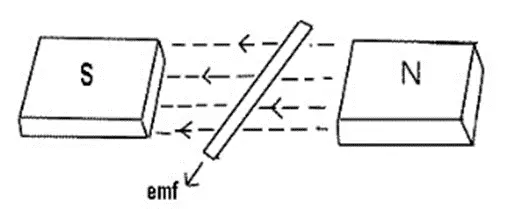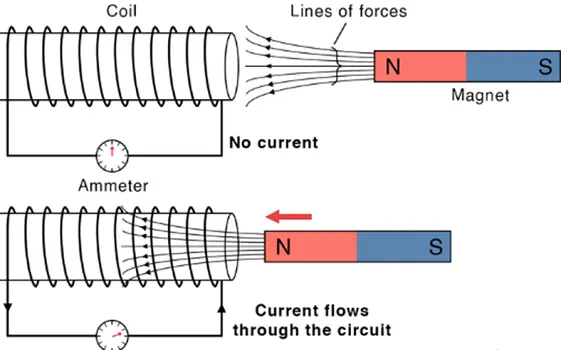Lenz’s law is defined as the induced electromotive force with distinct polarities producing a current whose magnetic field denies the change in magnetic flux through the loop to make sure that the original flux is managed through the loop when current flows in it. Lenz’s Law is named after Emil Lenz, a physicist, who formulated it in 1834. Lenz’s Law predicts the direction of many effects in electromagnetism, like the direction of voltage induced in a wire loop or inductor by a changing current, or the force of eddy currents applied to moving objects in a magnetic field.
When a current is originated by a magnetic field, then the magnetic field caused by the induced current will produce its magnetic field. Thus, this magnetic field will be different from the magnetic field that created it. Lenz’s law is based on Faraday’s law of Induction in which it says that a changing magnetic field will produce a current in a conductor, whereas according to Lenz’s law, the direction of the produced current, which opposes the beginning changing magnetic field which produced it.
Lenz’s Law Formula
Lenz’s law is indicated in the formula for Faraday’s law by the negative sign. Therefore, the formula is:

Where,
Emf= induced voltage
N= number of loops
Lenz’s LawApplications
The application of Lenz’s Law is mentioned below:
- Lenz’s law is used in induction cooktops and electromagnetic brakes.
- Eddy current balances
- Metal detectors
- It is applied to AC generators, electric generators
- Card readers
- Eddy current dynamometers
- Braking systems on train
- Microphones
Lenz Law Experiment
To find the current and direction of the induced electromotive force we use Lenz’s law. Some of the experiments are below.

First Experiment:
In the first experiment, we can see that the magnetic field lines are produced when the current in the coil flows in the circuit. As the current flows through the coil rises, the magnetic flux will also rise. The direction of the flow of the produced current will be such that it opposes when the magnetic flux rises.
Second Experiment:
In the second experiment, we can see that when the current-carrying coil is damaged on an iron rod and is moved in the direction with its left end behaving as N-pole and is moved in the direction of coil S, an induced current will form.
Third Experiment:
In the third experiment, we will find that the coil is pulled in the direction of the magnetic flux, and the coil linked goes on reducing which means that the area of the coil inside the magnetic field reduces.
According to Lenz’s law, the motion of the coil is different when the induced current is applied in a similar direction. Force is exerted by the magnet in the loop, to produce current. To dispute the change a force must be used by the current on the magnet.
Example of Lenz Law
In an aluminum or copper pipe, there is the existence of large magnetic fields that cause counter-rotating currents. Falling the magnet through the pipe illustrates this particular phenomenon. When the magnet is being dropped within the pipe it tends to go down at a rate that is less than when it is dropped outside the pipe. Here there is a current induced which can be identified by using the right-hand rule.
Electromagnetic Induction
Electromagnetic Induction is a current that is produced because of voltage production due to a changing magnetic field. Electromagnetic Induction either happens when a conductor is continuously moving in a stationary magnetic field or a conductor is placed in a moving magnetic field. In 1831, Electromagnetic Induction was discovered by Michael Faraday, and James Clerk Maxwell defined it Mathematically as Faraday’s law of induction.
Electromagnetic Induction Experiment

In the above diagram, Michael Faraday arranged a conducting wire that is attached to an instrument to calculate the voltage across the circuit. The voltage detector calculates the voltage in the circuit when a bar magnet is moved through the coiling. Michael Faraday, through his experiment, discovered that there are a few factors that affect this voltage production. They are:
- Number of Coils: The induced voltage is directly proportionate to the number of coils/ turns of the wire. The greater the number of turns, the greater the number of voltages formed.
- Changing Magnetic Field: Changing magnetic field impacts the induced voltage. This can be done by either moving the conductor in the magnetic field or moving the magnetic field around the conductor.
Applications of Electromagnetic Induction
Electromagnetic induction is found in many applications that include electrical components such as transformers and inductors and devices like generators and electric motors. The application of Electromagnetic Induction is discussed in the below points:
- AC generators run on the principle of electromagnetic induction.
- The magnetic flow meter is found on electromagnetic induction.
- The working of electrical transformers is found in electromagnetic induction.
Electromagnetic Induction Formula
Mathematically, the induced voltage can be written in the following way:
![]()
Where,
e= induced voltage (in volts)
N= number of turns in the coil
Φ= magnetic flux – the amount of magnetic field at a surface
t = time (in seconds)
The importance of this discovery is a way of generating electrical energy in a circuit by utilizing magnetic fields and not just batteries. Everyday machines like generators, electric motors, and transformers work on the principle of electromagnetic induction.
Santosh Kumar, the author behind IndiasStuffs.com, is passionate about sharing valuable insights on a variety of topics, including lifestyle, technology, and Indian culture.
Page Contents


